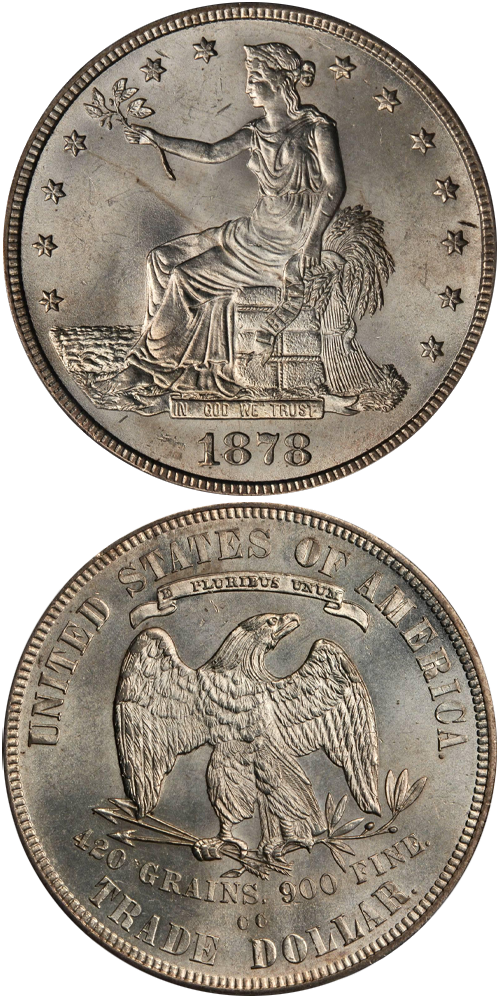1878-CC Trade Dollar
Jeff Ambio: The digit 8 in the date is "normal" (i.e., not repunched), and the first C in the mintmark is lower than the second. This reverse die was also used to strike some 1877-CC trade dollars.
Rusty Goe: Mixed messages about the trade dollar's future rippled across the newswires in early 1878. Treasury Secretary John Sherman had announced in late 1877 that the need for the large exchange-coins had ended.
A Washington, DC correspondent for the Daily Alta California addressed a growing concern about the trade dollar in his January 30, 1878 article. "At the present price of silver and gold," he wrote, "and the value of greenback dollars, Trade dollars can be placed in domestic circulation at a profit of three to four percent, to owners of bullion." This situation had created a problem because large quantities of the trade dollars minted in San Francisco had been shipped to the eastern states, as bullion dealers had taken advantage of the arbitrage opportunity. The Coinage Act of 1873 had left the door open for trade dollars to circulate domestically. As the price of silver had fallen, trade dollars, even with their heavier weights, had lost as much as ten percent of their value.
Even as trade dollar production had ceased at Philadelphia, "bullion dealers in New York and elsewhere in the East demand[ed] that the Philadelphia Mint ... be opened" to resume the same. President Hayes's cabinet temporarily relented and decided to allow the Philadelphia Mint to receive deposits for trade dollars again. At the same time, the Treasury ordered that the San Francisco and Carson City Mints should continue to make trade dollars.
The coiners in Carson City ran 56,000 pieces through the press in January, and added 41,000 more in February, the last run of trade dollars struck at Nevada's mint. The only ones minted in Philadelphia were the 900 Proof specimens made between January and May, all reserved for collectors. The San Francisco Mint delivered one last run of 35,000 pieces in April, by which time the government had made its final decision -- no more trade dollars.
After the Treasury ended the trade dollar experiment, Superintendent Crawford received orders to melt 52,852 of the remaining pieces on premises, presumably all dated 1878. Already the lowest mintage figure for that denomination at Carson City, the 1878-CC became even more so.
This is of course the most prized date in the business-strike series of trade dollars. Possibly one quarter to one half of one percent of the original mintage figure survives today, in all condition ratings (If we use the after-meltdown figure, the percentage of survivors rises to as high as one percent). In grades above AU-58, this date becomes increasingly scarce, and in the top condition-census ratings, it is extremely rare, although there appears to be a disproportionate number of Mint State examples extant (possibly 35 to 45 pieces).
Q. David Bowers: The Carson City mintage for 1878, the final year of trade dollar production, was only 97,000. By early 1878 when production of the trade dollar ceased, mintage figures included 4,211,400 at the Carson City Mint, 5,107,539 at the Philadelphia Mint (as for most of the period silver coins did not circulate in the East and Midwest), and a record 26,647,000 at San Francisco (the point of embarkation for most trade dollars shipped to China).
The example to the left was sold by Stack's Bowers Galleries in the August 2012 Battle Born Collection of Carson City Coinage, where it realized $70,500.






